An Experimental and Numerical Case Study of Passive Building Cooling with Foundation Pile Heat Exchangers in Denmark
Abstract
:1. Introduction
2. Materials and Methods
2.1. Study Site and Geological Setting
2.2. The Energy Pile Foundation and the Heating, Ventilation and Air Conditioning (HVAC) System
2.3. Building Characteristics and Passive Cooling Test from 2018-06-30 to 2018-08-10
2.4. Passive Heat Exchanger Model
2.5. Energy Pile Fluid Temperature Model
2.6. Combined Passive Heat Exchanger and Energy Pile Temperature Model
2.7. Predicted Mean Vote and Predicted Percentage Dissatisfied (PMV/PPD) Model of Thermal Comfort
2.8. Building Energy Model
3. Results and Discussion
3.1. Passive Cooling Test
3.1.1. Temperature
3.1.2. Humidity and Ventilation Rates
3.1.3. Cooling Power and Energy Efficiency Ratio
3.1.4. Thermal Comfort (PMV and PPD)
3.2. Comparison of the Required and Available Passive Cooling at Rosborg Gymnasium
Author Contributions
Funding
Acknowledgments
Conflicts of Interest
Appendix A
References
- IPCC. Climate Change 2013: The Physical Science Basis, Fifth Assessment Report (AR5); IPCC: New York, NY, USA, 2014; Available online: http://www.ipcc.ch/report/ar5/wg1/ (accessed on 6 March 2019).
- The Danish Government. The Danish Climate Policy Plan—Towards a Low Carbon Society. 2013. Available online: https://ens.dk/sites/ens.dk/files/Analyser/danishclimatepolicyplan_uk.pdf (accessed on 10 May 2019).
- The Danish Energy Agency. Denmark’s Energy and Climate Outlook 2018–Baseline Scenario Projection Towards 2030 With Existing Measures (Frozen Policy); The Danish Energy Agency: København, Denmark, 2018; ISBN 978-87-93180-34-5.
- Bygningsreglementet. Available online: https://historisk.bygningsreglementet.dk (accessed on 10 May 2019).
- Larsen, T.S.; Jensen, R.L.; Daniels, O. The Comfort Houses—Measurements and Analysis of the Indoor Environment and Energy Consumption in 8 Passive Houses 2008–2011; Department of Civil Engineering, Aalborg University: Aalborg, Denmark, 2012. [Google Scholar]
- Lomas, K.J.; Porritt, S.M. Overheating in Buildings: Lessons from Research. Building Res. Inf. 2017, 45, 1–18. [Google Scholar] [CrossRef]
- Danish District Heating Association. Cooling Plan Denmark 2016; Danish District Heating Association: Copenhagen, Denmark, 2016; Available online: https://dbdh.dk/wp-content/uploads/2015-04-K%C3%B8leplan-Danmark-2016.pdf (accessed on 9 April 2019).
- IPCC. Climate Change 2014: Impacts, Adaption, and Vulnerability. Part A: Global and Sectoral Aspects, Fifth Assessment Report (AR5); IPCC: New York, NY, USA, 2014; Available online: https://www.ipcc.ch/report/ar5/wg2/ (accessed on 6 March 2019).
- Lund, J.W.; Boyd, T.L. Direct utilization of geothermal energy 2015 worldwide review. Geothermics 2016, 60, 66–93. [Google Scholar] [CrossRef]
- Li, Z.; Zhu, W.; Bai, T.; Zheng, M. Experimental study of a ground sink direct cooling system in cold areas. Energy Build. 2009, 41, 1233–1237. [Google Scholar] [CrossRef]
- Sarbu, I.; Sebarchievici, C. General review of ground-source heat pump systems for heating and cooling of buildings. Energy Buildings 2014, 70, 441–454. [Google Scholar] [CrossRef]
- Javed, S.; Fahlén, P.; Claesson, J. Optimization of Ground-Storage Heat Pump Systems for Space Conditioning of Buildings; Department of Energy and Environment, Chalmers University of Technology: Gothenburg, Sweden, 2014. [Google Scholar]
- Lee, S.R. Energy Piles—Piles as Heat Exchangers; KAIST: Daejeon, Korea, 2009. [Google Scholar]
- Laloui, L.; Nuth, M.; Vulliet, L. Experimental and numerical investigations of the behaviour of a heat exchanger pile. Int. J. Numer. Anal. Methods Geomech. 2006, 30, 763–781. [Google Scholar] [CrossRef]
- Schröder, B.; Hanschke, T. Energy piles: Environment-friendly heating and cooling with geothermally activated prefabricated piles of reinforced concrete, construction technology. Bautechnik 2003, 80, 925–927. [Google Scholar]
- Geelen, C.; Krosse, L.; Sterrenburg, P.; Bakker, E.J.; Sijpheer, N. Energy Pile Handbook; TNO Milieu, Energie en Procesinnovatie: Apeldoorn, The Netherlands, 2003; p. 93. [Google Scholar]
- Brandl, H. Energy foundations and other thermo-active ground structures. Geotechnique 2006, 56, 81–122. [Google Scholar] [CrossRef]
- Laloui, L.; Donna, A.D. Energy Geostructures: Innovation in Underground Engineering; John Wiley & Sons: Hoboken, NJ, USA, 2013; p. 320. ISBN 978-1-848-21572-6. [Google Scholar]
- Pahud, D.; Fromentin, A.; Hubbuch, M. Heat exchanger pile system for heating and cooling at Zürich airport. IEA Heat Pump Centre Newsl. 1999, 17, 15–16. [Google Scholar]
- Fanger, P.O. Thermal Comfort; Danish Technical Press: Copenhagen, Denmark, 1970. [Google Scholar]
- Alberdi-Pagola, M.; Poulsen, S.E.; Loveridge, F.; Madsen, S.; Jensen, R.L. Comparing heat flow models for interpretation of precast quadratic pile heat exchanger thermal response tests. Energy 2018, 145, 721–733. [Google Scholar] [CrossRef]
- Alberdi-Pagola, M.; Poulsen, S.E.; Jensen, R.L.; Madsen, S. Thermal design method for multiple precast energy piles. Geothermics 2019, 78, 201–210. [Google Scholar] [CrossRef]
- ISO 7730:2005. Ergonomics of the Thermal Environment—Analytical Determination and Interpretation of Thermal Comfort Using Calculation of the PMV and PPD Indices and Local Thermal Comfort Criteria, 3rd ed.; International Organization for Standardization: London, UK, 2015; p. 52. [Google Scholar]
- Hoyt, T.; Schiavon, S.; Piccioli, A.; Cheung, T.; Moon, D.; Steinfeld, K. CBE Thermal Comfort Tool, Center for the Built Environment; University of California Berkeley: Berkeley, CA, USA, 2017; Available online: http://comfort.cbe.berkeley.edu/ (accessed on 24 April 2019).
- EnergyPlus. Documentation of EnergyPlus: The Official Building Simulation Program of the United States Department of Energy; United States Department of Energy: Washington, DC, USA, 2019. Available online: https://energyplus.net/ (accessed on 29 April 2019).
- DesignBuilder. Available online: https://www.designbuilder.co.uk (accessed on 13 October 2018).
- American Society of Heating, Refrigerating and Air-Conditioning Engineers, Inc. ASHRAE Guideline: Measurement of Energy and Demand Savings; American Society of Heating, Refrigerating and Air-Conditioning Engineers, Inc.: Atlanta, GA, USA, 2002. [Google Scholar]
- Fowler, C.M.R. The Solid Earth, An Introduction to Global Geophysics; Cambridge University Press: Cambridge, UK, 2005; pp. 230–231, 685. [Google Scholar]
- DMI (Danish Meteorological Institute). DMI Report 16–19 Version 2. Climate Data Denmark. Municipal Reference Data 2006–2015. Monthly and Annual Temperatures, Precipitation and Sunshine. The Municipal Weather and Climate; DMI: Copenhagen, Denmark, 2016; p. 210. [Google Scholar]



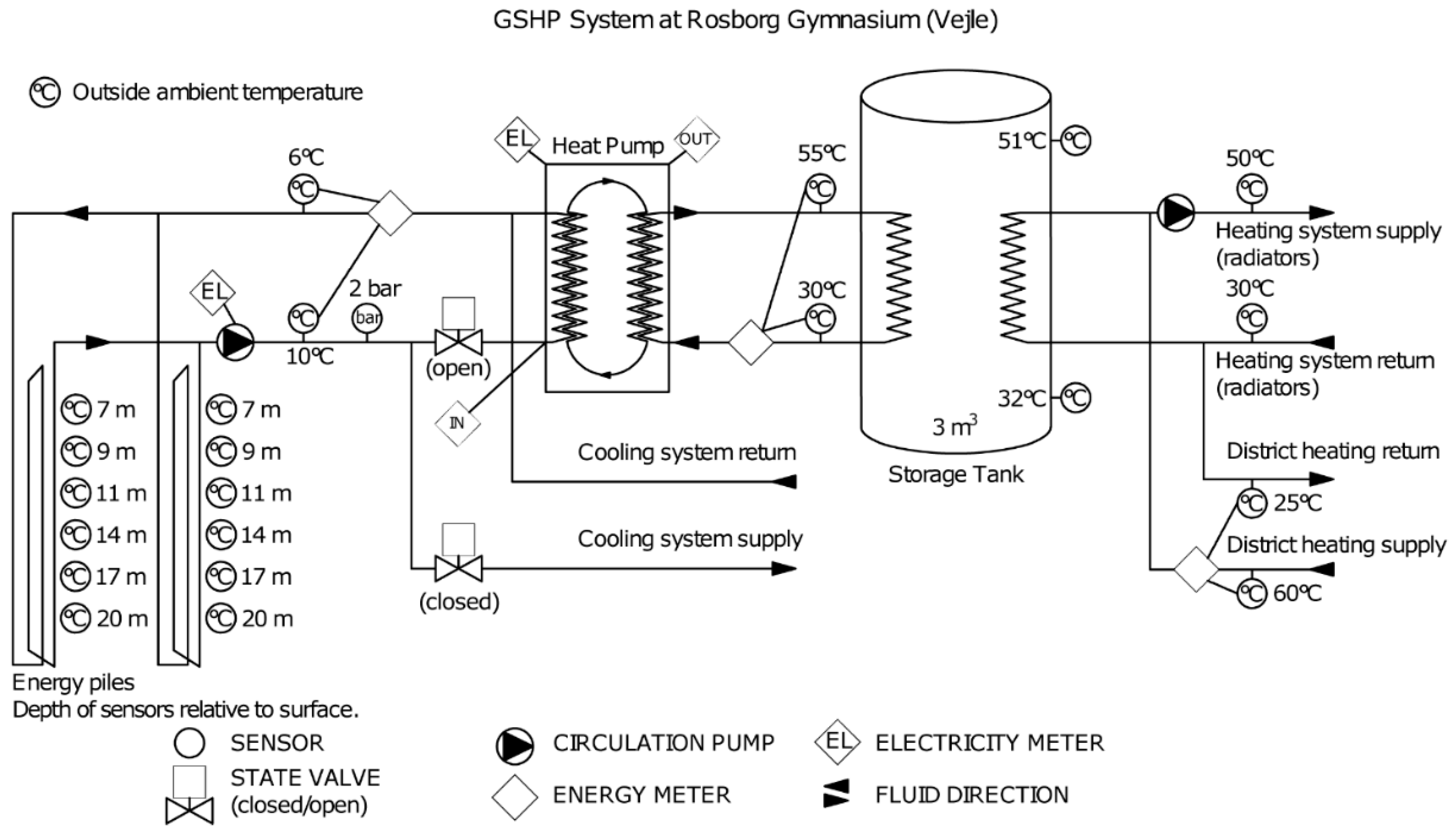

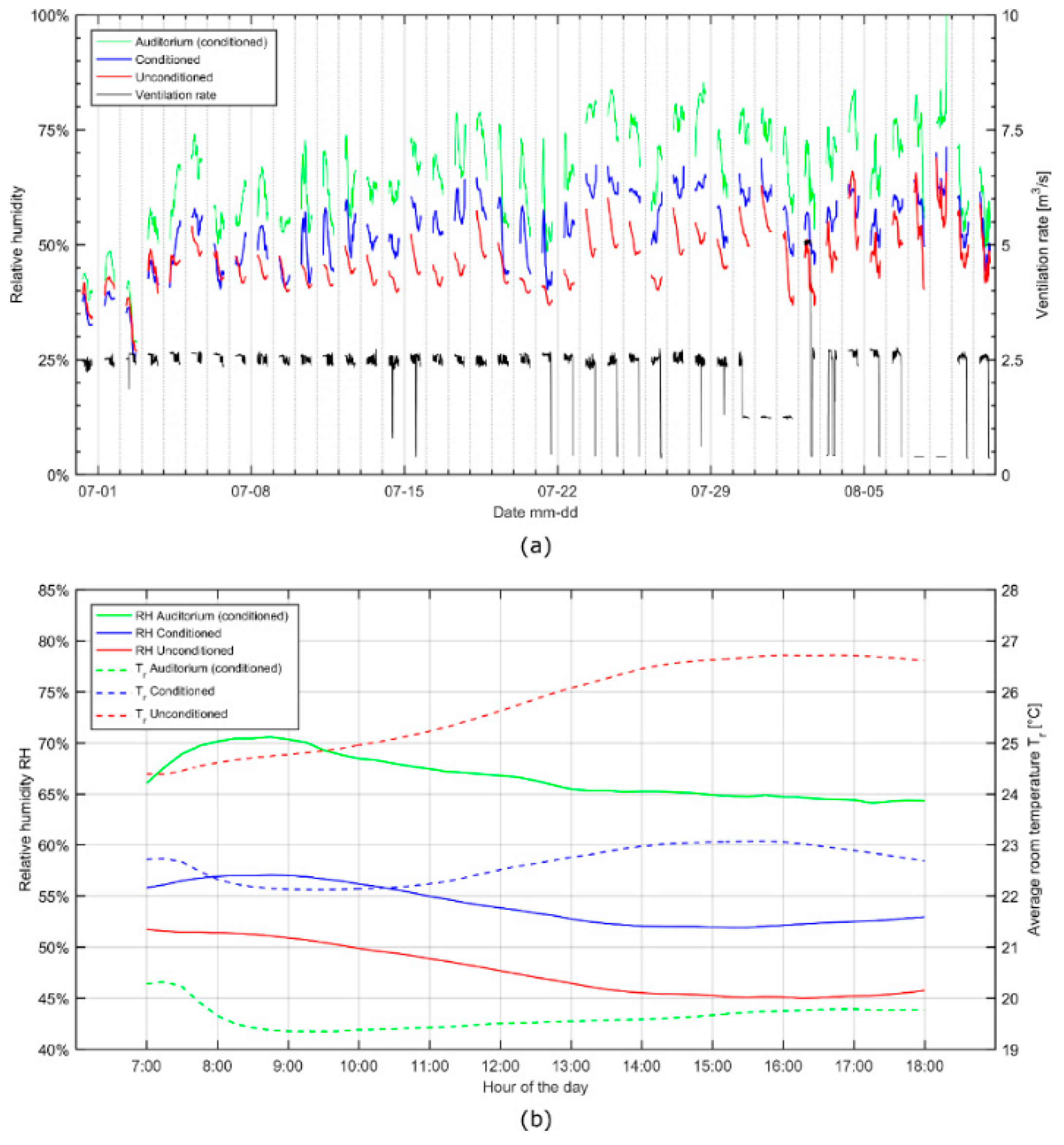
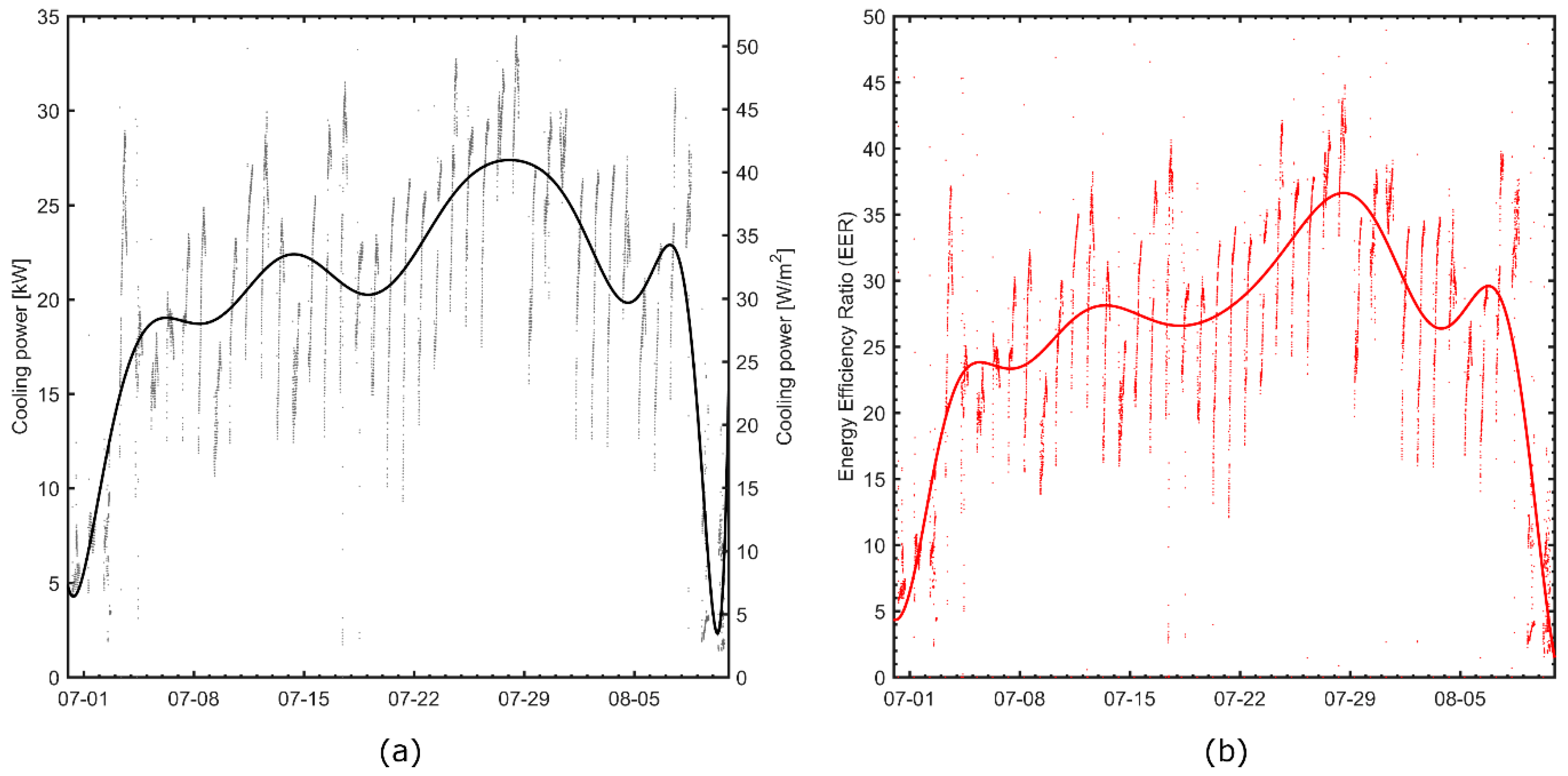

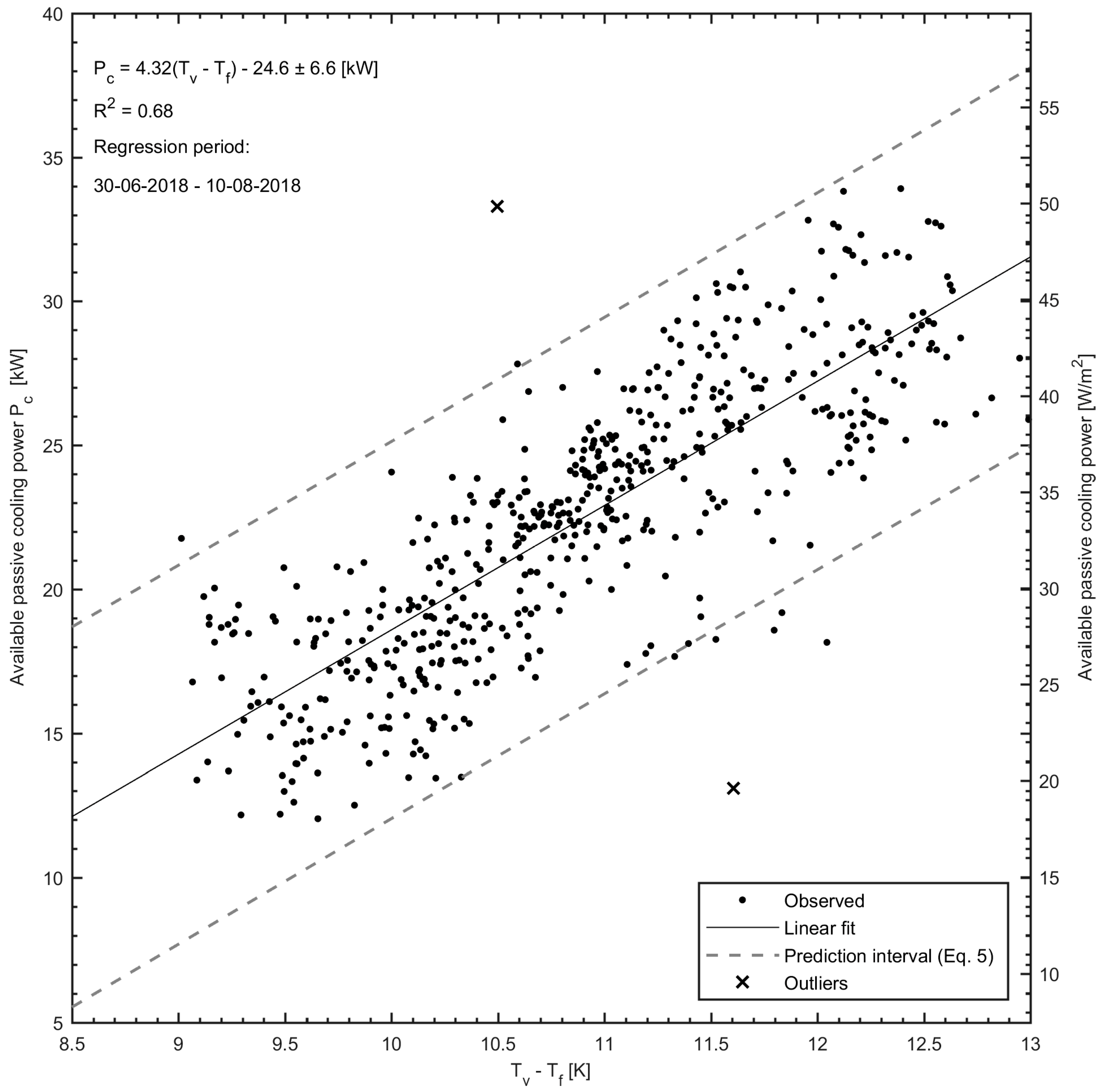
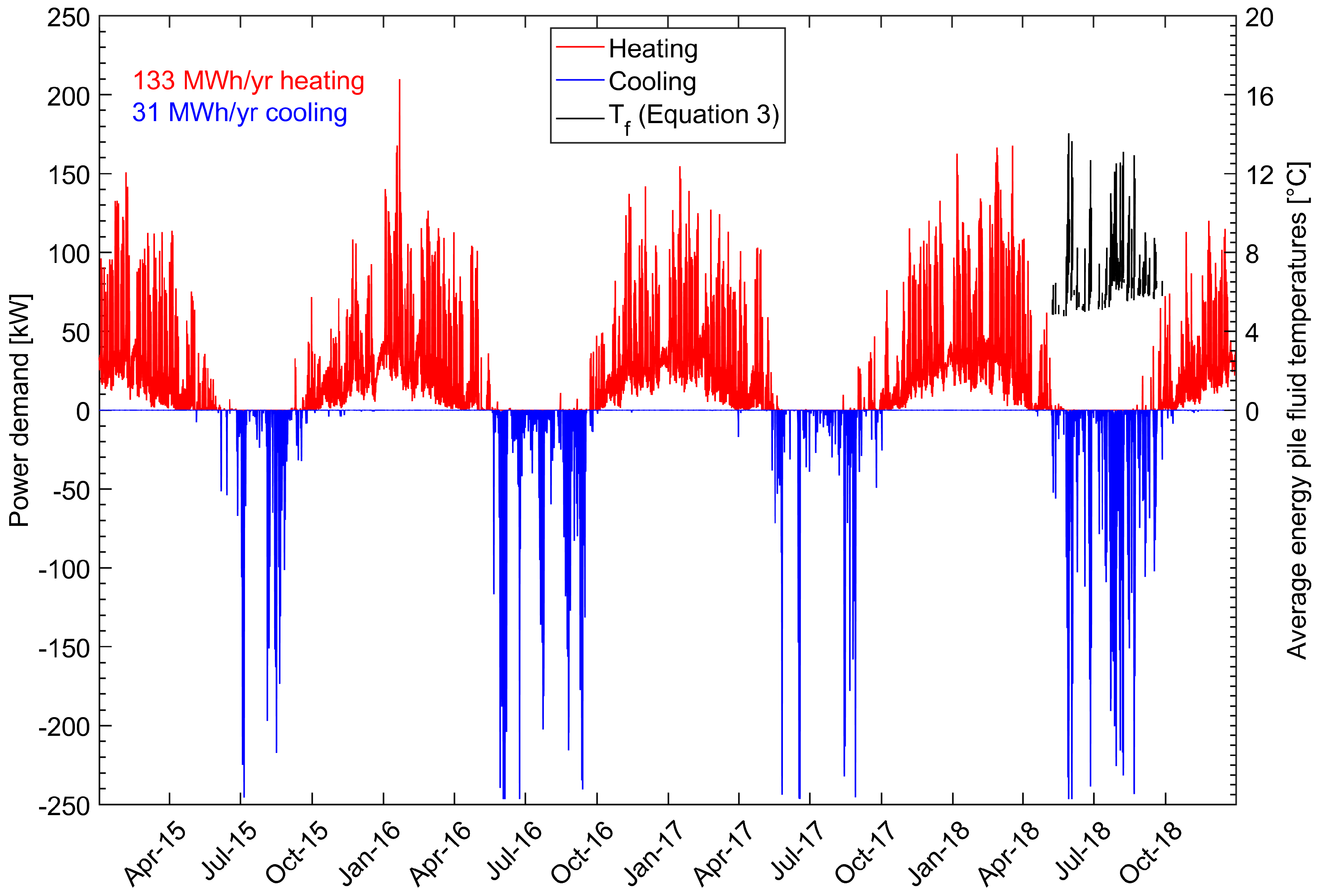

| M, metabolic rate (W/m2) | 69.8 (1.2 met) |
| W, mechanical power (W/m2) | 0 |
| Icl, clothing insulation m2⋅K/W | 0.155, 1 clothing unit (Clo) |
| f, clothing surface factor (1) | Computed |
| ta, air temperature (°C) | Computed |
| tr, mean radiant temperature (°C) | ta |
| va, relative air velocity (m/s) | 0.2 |
| pa, water vapour partial pressure (Pa) | Measured (relative humidity) |
| hc, convective heat transfer coefficient (W/m2/K) | Computed |
| tcl, clothing surface temperature (°C) | Computed |
| Occupancy/Time | 7:30–8:00 | 8:00–11:30 | 11:30–12:00 | 12:00–16:00 |
|---|---|---|---|---|
| Classrooms | 10% (minor) | 100% (full) | 50% (medium) | 100% (full) |
| Halls/corridor | 100% (full) | 35% (some) | 100% (full) | 35% (some) |
| Parameter/Room Class | Hall | Laboratory | Class Room | General |
|---|---|---|---|---|
| Total area fraction (%) | 28.3 | 18 | 27.6 | 26.1 |
| Occupancy density (people/m2) | 1 | 0.25 | 0.65 | 0 |
| Latent fraction | 0.5 | 0.5 | 0.5 | 0.5 |
| Metabolic rate | Eating | Standing | Sitting | Walking |
| Schedule * | Hall/corridor | Classrooms | Classrooms | Hall/corridor |
| Laptop (W/m2) | 1 | 1 | 1 | No |
| Office equipment | No | No | No | No |
| Miscellaneous (W/m2) | 1 | 50 | 0 | 0 |
| Lighting | Yes | Yes | Yes | Yes |
| Cooling set point (°C) | 26 | 26 | 26 | 26 |
| Heating set point (°C) | 22 | 22 | 22 | 22 |
| Natural ventilation | No | No | No | No |
| Mechanical ventilation (l/s/m2) | 0.3 | 0.3 | 0.3 | 0.3 |
© 2019 by the authors. Licensee MDPI, Basel, Switzerland. This article is an open access article distributed under the terms and conditions of the Creative Commons Attribution (CC BY) license (http://creativecommons.org/licenses/by/4.0/).
Share and Cite
Poulsen, S.E.; Alberdi-Pagola, M.; Cerra, D.; Magrini, A. An Experimental and Numerical Case Study of Passive Building Cooling with Foundation Pile Heat Exchangers in Denmark. Energies 2019, 12, 2697. https://doi.org/10.3390/en12142697
Poulsen SE, Alberdi-Pagola M, Cerra D, Magrini A. An Experimental and Numerical Case Study of Passive Building Cooling with Foundation Pile Heat Exchangers in Denmark. Energies. 2019; 12(14):2697. https://doi.org/10.3390/en12142697
Chicago/Turabian StylePoulsen, Søren Erbs, Maria Alberdi-Pagola, Davide Cerra, and Anna Magrini. 2019. "An Experimental and Numerical Case Study of Passive Building Cooling with Foundation Pile Heat Exchangers in Denmark" Energies 12, no. 14: 2697. https://doi.org/10.3390/en12142697
APA StylePoulsen, S. E., Alberdi-Pagola, M., Cerra, D., & Magrini, A. (2019). An Experimental and Numerical Case Study of Passive Building Cooling with Foundation Pile Heat Exchangers in Denmark. Energies, 12(14), 2697. https://doi.org/10.3390/en12142697





